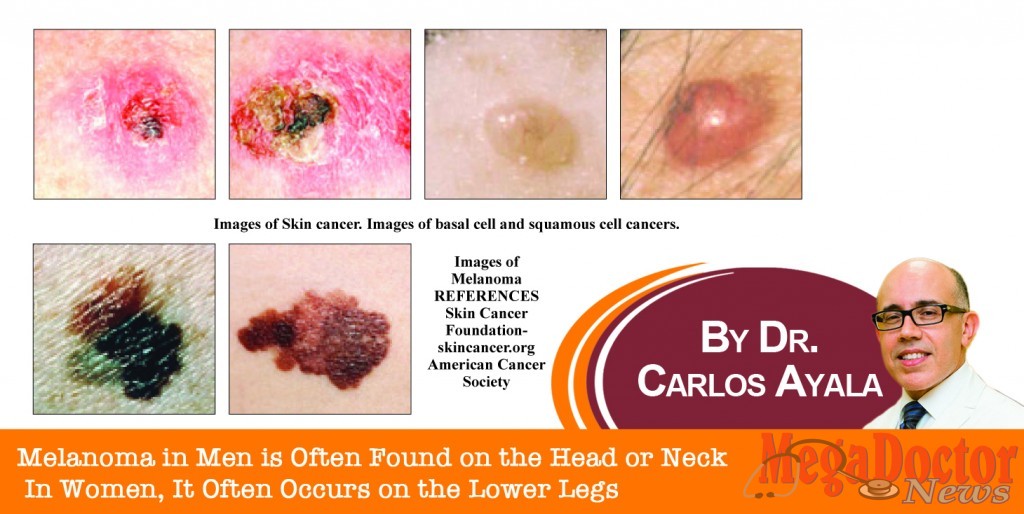
Mega Doctor News
The Rio Grande Valley is getting ready for the summer. Spring flowers are blooming, days are longer and there is more time to be out in the sun. People are starting to get in shape to look better in their bathing suits and getting in those solar rays.
Soon school will end for the summer break and families will be traveling. More sun means more Vitamin D and researchers are still finding new health benefits to taking this ‘Sun Vitamin”. However whenever possible you should try to get your Vitamin D through dietary sources and vitamin supplements instead of sun exposure to not increase your risk of skin cancer.
May is Skin Cancer Awareness Month. More than 2 million people in the United States are diagnosed with nonmelanoma (basal or squamous cell) skin cancer each year. The number of new melanoma cases increases each year. In 2014, it is estimated that there will be almost 140,000 new cases of melanoma, the most serious type of skin cancer. By 2015, it is expected that about 1 in 50 Americans will develop melanoma in their lifetime; about 1 in 5 Americans will develop skin cancer in their lifetime.
These may be alarming statistics but skin cancer is the most common form of cancer in the United States. Each year there are more new cases of skin cancer than the combined incidence of cancers of the breast, prostate, lung and colon. You need to know the risk factors of having skin cancer.
Risk factors may include:
Sun exposure-Some people who spend a lot of time in the sun may develop skin cancer if they do not protect their skin with sunscreen or clothing. As well as tanning in the sun or in a tanning bed.
Fair skin-If you have fair skin, blonde or red hair, or light-colored eyes and get freckles or sunburns easily, you are more likely to get skin cancer than a person with darker skin a history of sunburns-If you had 1 or more sunburns that blistered when you were a child or teenager, you are at risk for developing skin cancer as an adult
A personal history of skin cancer-Having had skin cancer in the past increases your risk for skin cancer in the future.
A family history of skin cancer-You may be at risk for skin cancer if one of your parents or a sibling has had skin cancer.
Certain medicines and health conditions-If you take some types of medicine or have certain health conditions that weaken the body’s ability to fight off disease, you may be at increased risk for skin cancer.
Multiple or unusual moles
Types of skin cancer include Basal Cell & Squamous Cell Carcinoma and Melanoma.
Basal cell carcinoma is the most common type of skin cancer in the United States, especially in people with fair skin. This type of cancer grows slowly; it usually appears on sun-exposed areas of the skin, such as the face, scalp, neck, arms, and legs.
It will usually appear as a bump or growth that can be pearly or waxy, pink, flesh-colored or brown, a sore that bleeds easily or does not heal, a sore with a sunken area in the middle. It has a low risk of metastasis and high likelihood of cure if treated.
Squamous Cell Carcinoma is the second most common type of skin cancer in the United States and the most common type of skin cancer in people with dark skin. It is more common in the elderly. It can be much more aggressive. It also grows on sun-exposed skin, such as the face, ears, neck, hands, and arms. If found early and treated, squamous cell carcinoma is highly likely to be cured. If allowed to grow without treatment it can spread to other parts of the body, including internal organs. Patients will usually present with a bump or lump on the skin that can feel rough, a sore or scar that does not heal, a flat, reddish, scaly patch that grows slowly.
Melanoma, which occurs less often than the other types of skin cancer, is the most serious and most dangerous type of skin cancer and is the cause of most skin cancer deaths. Melanoma begins in melanocytes (pigment cells that give skin its color). Melanoma is also more likely than other kinds of skin cancer to spread to other parts of the body (metastasize). Melanoma can occur on any skin surface.
In men, melanoma is often found on the head or neck or on skin between the shoulders and the hips. In women, it often occurs on the lower legs or on skin between the shoulders and the hips. People with dark skin rarely get melanoma. When they do, it is often found under the fingernails or toenails, on the soles of the feet, or on the palms of the hands.
It is easier to treat melanoma when the disease is limited to a small area of the skin. It is much harder to treat once it spreads to other parts of the body.
Signs of Melanoma- look for ABCDE:
Asymmetry: One half does not match the other half
Border: Irregular, ragged edges
Color: More than 1 color; shades of black, brown, and tan may be present; areas of white, gray, pink, red, or blue may also be seen
Diameter: Larger than a pea (¼ inch, or 6 millimeters), though some melanomas can be tiny
Evolving: Raised, changing size, shape, or color over time
How to prevent skin cancer and damage to our skin from the sun:
The best way to lower your skin cancer risk or prevent skin cancer is to limit the amount of time you spend in the sun. If you want a tan, one option is to use a sunless tanning lotion, which can provide a darker look without the danger
When you are in the sun, be sure to wear a “Broad-Spectrum” (UVA/UVB) sunscreen and lip balm with a Sun Protective Factor (SPF) of 30 or higher.
Cover up with clothing, including a broad-brimmed hat and UV-blocking sunglasses.
Be extra careful to cover up, limit exposure, and apply sunscreen to children to diminish their lifetime risk of skin cancer. Babies younger than 6 months should be kept out of direct sunlight and protected from the sun using hats and protective clothing.
Avoid sunlamps and tanning booths. One indoor UV tanning session increases users’ risk of developing squamous cell carcinoma by 67 percent and basal cell carcinoma by 29 percent. Just one indoor tanning session increases users’ chances of developing melanoma by 20 percent, and each additional session during the same year boosts the risk almost another two percent.
Finally, year round skin protection with at least an SPF 15 skin cream has been shown to decrease wrinkles, brown spots, and sagging skin associated with aging. If you think you may have a suspicious lesion on your skin see your physician or visit us at: Ayala ENT & Facial Plastic Surgery for an evaluation, 2727 W Trenton Rd. Edinburg, TX 78539 or call us at 956-631-4515. www.texasfaceandnose.com MDN












